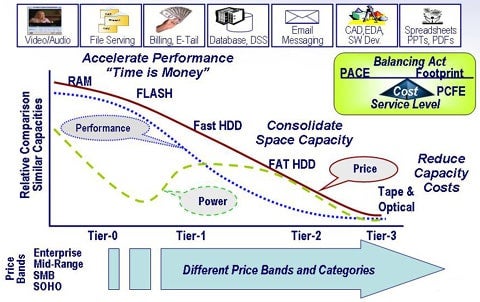Don’t schedule the funeral for tape just yet. Tape has been declared dead as a technology for more than a decade, yet organizations of all sizes continue to rely on magnetic tape as a core piece of their data protection strategies.
More recently, the magnetic disk drive has been pronounced dead thanks to increasing implementation of solid state devices (SSD) based on Flash, RAM or a combination. Growing adoption of SSD-based technologies also takes the pressure off of magnetic hard disk drives (HDDs), enabling them to expand into new roles and uses, some of which — such as daily backups — had been done by tape.
With HDDs taking over the task of supporting daily backups, that makes magnetic tape available for other implementations. Tape is being used for data preservation, including archiving for compliance and traditional non-compliance purposes such as saving project or other transient data that may be needed in the future. Given the continued enhancements and deployment by IT organizations, magnetic tape still has plenty of useful service into the foreseeable future.
Tape has been used for many different tasks in addition to backup and archive, including as near-line storage to supplement on-line magnetic disk storage capacity to enable sequential and batch processing. With the expanded storage capacities available with magnetic disk drives, tape is still being used for backups even as disk drives continue to be used for daily incremental, point in time copy snapshots and other forms of disk-to-disk (D2D) data protection. While disk-only vendors continue to talk about eliminating tape, many industry leaders continue to innovate by enabling their customers to use disk-based virtual tape libraries (VTLs) that include the ability to compress, encrypt, de-duplicate and replicate to off-site remote storage as well as migrate data off of disk to tape-based media.
Since different types of storage media have various characteristics, strengths and value propositions, their positioning and alignment to the applicable task and point in time makes sense in a tiered storage model, such as that shown in Figure 1 below. The basic premise of tiered storage, similar to that of tiered access and tiered data protection, is to align the applicable type of technology to the task at hand to meet specific service and budget requirements. Think of it as specialized storage to address specific pain points in a cost- and quality of service-effective manner. Essentially, each technology has its own sweet spot for deployment in terms of performance, availability, capacity and energy consumption per given footprint and cost point. Consequently, some storage mediums, including RAM- and FLASH-based SSD, along with magnetic tape, are being used in more specific and specialized roles to optimize that value propositions.
Figure 1: Complementary Tiers of Storage Mediums and Media for different tasks
Magnetic tape remains viable today even when most discussions center on disk-based and other future or emerging technologies for data protection centers. There are several reasons for this. There have been performance, availability and capacity improvements to magnetic tape that continue to make its use cost-effective. Tape can be easily added to enhance an existing tape ecosystem. The addition of tape tracking, encryption, media handling and management to address customer pain points continue to appear in the market for tape-based solutions.
Tape is often viewed as a low-tech storage medium compared to other emerging or future technologies; however, the reality is that tape continues to be used by organizations of all sizes for mission-critical data protection and data preservation. As for the lack of high-tech in magnetic tape, all one has to do is look at how tape is able to increase densities and availability by using advanced materials, processes and techniques often associated only with disk drives or other technologies, combined with other low-level techniques.
Recent improvements and associated technologies that are helping keep tape relevant include increased capacity and improved reliability for a given cost and physical footprint as well as flexible approaches for data compression and key management. Tape also remains one of the most environmentally and green-friendly technologies from a power, cooling and floor space perspective, in addition to having good availability and performance per given capacity footprint. Tape is also a known and proven technology that addresses customers’ sensitivity to risk aversion and comfort zones around data protection and data preservation mediums.
Items to keep in mind moving forward include:
- Adherence to environmental health and safety regulations for media disposal
- Compliance and information security concerns pertaining to media disposal
- Removable media asset tracking and secure shipping accessories
- Regular media maintenance and management
- Additional accessories to facilitate media management and tracking
When combined with disk-based backup and archiving solutions, including VTLs, compression or de-duplication solutions, tape is a key component for enabling tiered data protection, leveraging tiered storage media and technologies. Different specialized technologies allow the flexibility to be used for diverse usage needs in the evolving data center, as shown in Figure 2 below. The result is that different technologies no longer need to be forced to perform functions or be used in roles outside of their intended purpose or value proposition role.
Figure 2: The evolving Green and Virtual Data Center
Moving forward, while tape remains relevant and viable for storing or preserving off-line data to support business continuity, disaster recovery and archiving, disk-based solutions such as VTLs will continue to gain in popularity for frequent snapshots, daily and incremental backups, with tape shifting to longer-term, bulk data preservation. Learn more about tiered storage, data protection management and other related topics at www.storageio.com as well as at www.thegreenandvirtualdatacenter.com.
Greg Schulz is founder and senior analyst of the StorageIO group and author of “Resilient Storage Networks” (Elsevier) and “The Green and Virtual Data Center” (Auerbach).




